We were up early this morning and perusing the news to check out the climate of La Paz, post election days.
Turns out there were demonstrations last night and a strike scheduled for tomorrow. We were hoping to get to Uyuni for our Salt Flats expedition tomorrow, so considering our options, we quickly threw our gear together, made a last minute change to our flight to Uyuni and hitched a ride to the airport.
By 2 pm we were settled in Uyuni, squared our tour away, spent some time catching up with family and sorted bags for our 3 day adventure. By 10 am the next day, we were acquainted with the 12 others in our group; our 2 drivers, our trusty English-speaking guide, 2 East Indians, 4 Kiwis, 3 Frenchman and of course, 2 well-rounded Newfoundlanders to top it all off!
We piled into two, Toyota 4x4s and off we went racing toward the Uyuni Salt Flats and the desert beyond. Our first stop was an unlikely one, a Train Cemetery.
Most of the trains here date back to the early 20th century and were imported from Britain. Uyuni was originally destined to become a major train destination connecting a variety of cities.
Those plans ultimately never came to fruition as both the mining industry lost momentum and also disputes with neighbouring countries broke out. The trains, 100 or more, stand quietly on the sand, weatherbeaten by Uyuni’s unique mix of strong salted winds. We spent an hour or so wandering the cemetery and crawling over the carcasses of these once proud steel structures. Spotted with graffiti, these lonely desert trains are a stark reminder of government corruption to locals but a goldmine of photogenic opportunity for tourists.
It wasn’t long before we were stealing away across the Uyuni Salt Flats as though we were on an aimless mission to catch the edge of the salt against the horizon.
The Salt Flats or Salar de Uyuni sits amid the Andes in southwest Bolivia and is the world’s largest salt flat. It’s the legacy of a prehistoric lake that went dry, leaving behind a desertlike, nearly 11,000 square kilometre landscape of bright-white salt, rock formations and cacti-studded islands. Though wildlife is rare in this unique ecosystem, it harbours many pink flamingos.
The Salt Flats are a queer thing with its endless white as far as the eye can see, stretching out 360 degrees. Mine and Paul’s only experience traversing expanses of white have been on snowmobiles travelling across a wintered country. It took a while to acclimate our senses as we travelled with the alertness of a snowmobiler, always cognizant of signs of wear on the country. The black streaks of worn salt resembled the marks of thin ice. The slip of tires on loose salt felt like ice giving way after fresh rain. After several hours, we managed to convince our minds-eye that this was salt, not snow/ice and we started to settle in and enjoy ourselves even more.
Marco, our guide was amazing! He had a great handle on Bolivia’s history, was informative and best of all, had a keen interest in amateur photography! Where many groups spent time fumbling around with cameras and playing with perspective shots against the salt flats and sky, Marco took full control of the situation.
For two, maybe three hours, Marco played with props, music and movement, instructing us all, every step of the way.
His efforts ultimately resulted in some fantastic, fun-filled pictures that none of us could ever have hoped for or imagined without him. He truly made our day on the Salt Flats! I have only included a sample of our pictures; I hope you enjoy them as much as we enjoyed making them!
Somewhere between Uyuni and where the Salt Flats met the desert, we visited Incahuasi Island. Set on the remains of a volcano, Incahuasi Island, was used as a resting place for the Incas who used to cross the salt flat with llamas.
Surrounded by kilometres of salt, Incahuasi Island is situated in the centre of the Salt Flat and at its highest point. This makes the island an ideal spot for tourists to enjoy amazing 360 degree panoramic views of the Uyuni Salt Flat.
The Island is particularly interesting for being covered by giant cacti, approximately 700 years old and 10 meters high! The island offers a unique landscape in the middle of this vast white sea. It was simply incredible to visit and the views from the summit were spectacular.
With the sun starting to set, we jumped aboard our 4x4 and set out to find the perfect place to stop and enjoy the sun, falling beyond the hills where desert was beginning to meet the flats. It was a sunset to rival many and one we soon won’t forget.
With the sun tucked firmly behind the hills, we set out in the darkness to find our salt-house dwelling for the night. We travelled in absolute darkness for a couple of hours and it was soon made clear why we needed 4x4s. Off of the salt and onto the sand, we made our way into the desert across pathways that were apparently locally known highways. To us, they were a barely maintained woods road, often with washouts that called for us to crawl down the side of one pathway and onto another.
For those not used to off-roading this must have certainly been a thrill. To us, it wasn’t the off-roading that was mesmerizing, but the fact we appeared to be in the middle of nowhere and the driver carried on as though the milk-path was a clearly marked, free way system. Eventually we arrived at a dwelling in the middle of nowhere. There were no lights and no signs of life nearby until we simply stopped and unloaded.
An oasis in the middle of nowhere! Wow! Our stay for the night involved a courtyard of tables and chairs made entirely of salt; here we enjoyed a late night supper. Our room had a bed with a headboard made of salt, walls made of salt and granulated salt on the floors! It was marvellously unusual and a great foreshadowing of the days to come.
The next two days were spent combing the Bolivian desert; hot as heck in the day and freezing cold at night. We visited colourful lagoons spotted with pats of flamingoes, some spotted or streaked; none wholly coloured in pink .
There were expanses of sand as far as the eye could see with mountains and volcanoes on the periphery. We stopped to admire several dormant volcanoes, one which has been smouldering for several hundred years.
We passed along herds of wild llamas, alpacas and vicunas, admired the unusual formations of lava rock spotting the desert and eyed a lonely fox sizing up a young vicuña.
At one point we stopped to admire a petrified tree in the middle of the desert. Not far from this area were another group of unusually placed volcanic rocks that was inhabited by a colony of rabbits looking suspiciously like Australian Rock Wallabies (miniature kangaroos) but without the marsupial pouch.
As the grand finale to our three day excursion, we visited geysers on our last day. They spouted in magnificent glory during the sunrise of our final day as we walked around the edges of their spouts, discovering hot spring and bubbling mud baths around their periphery.
Before 8 am we had spent an hour soaking in a nearby hot spring. I will confess, I wondered what my besties were doing at work while I breathed in the sweet smell of sulphuric goodness that comes with soaking in hot spring while one could be teaching Math! Loves it! Sorry girls ;)
By 5 pm, we rolled back into town, full to the brim, high on life! What a fantastic, action-packed, three day delight to the senses! Oh! Bolivia! You are AMAZING!

 Uyuni Salt Flat, Potosi Department, Bolivia
Uyuni Salt Flat, Potosi Department, Bolivia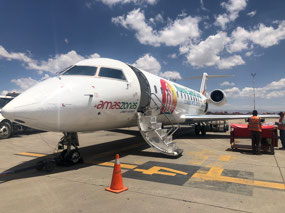
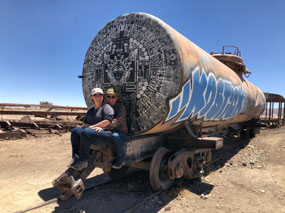
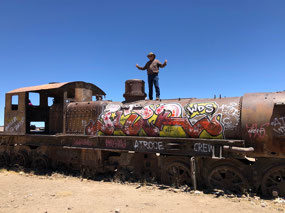
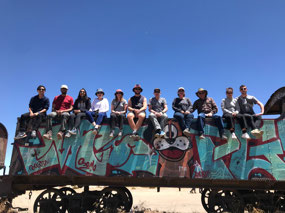
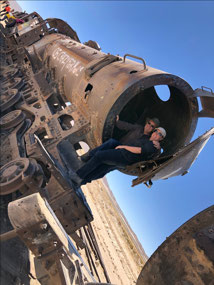
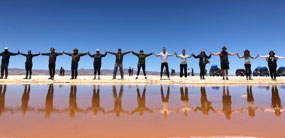






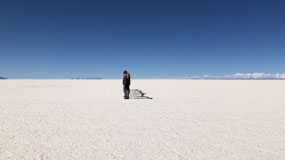
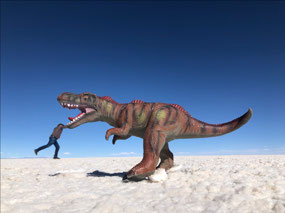
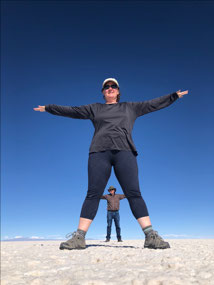
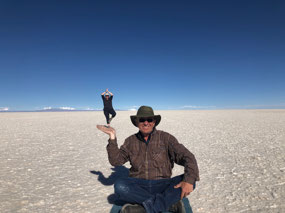

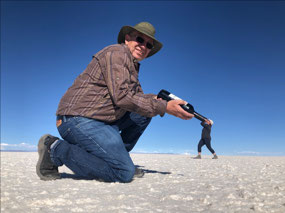
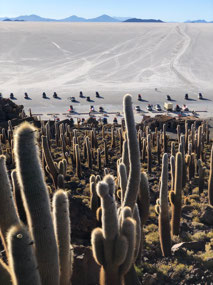
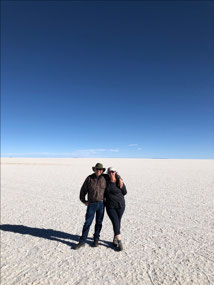
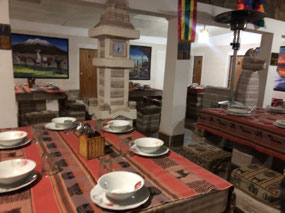
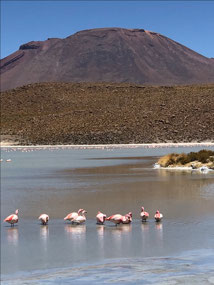
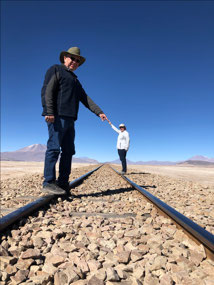
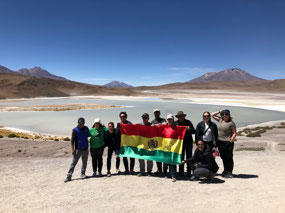
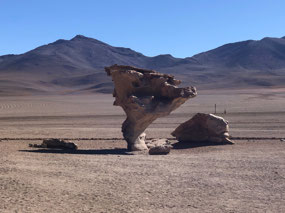
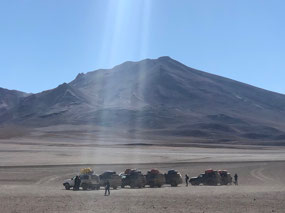
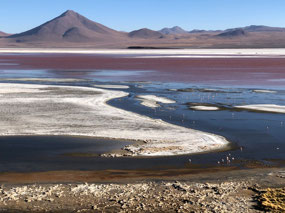
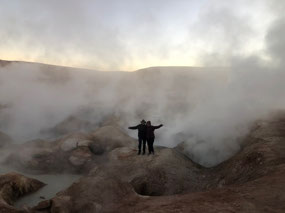
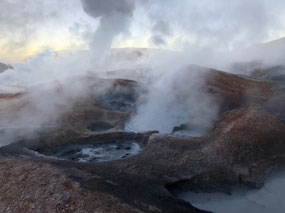
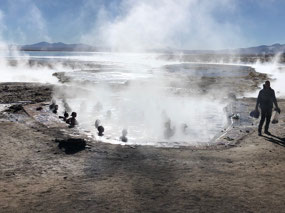
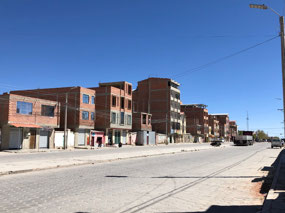
Aunt Theresa and Uncle John
2019-11-11
Absolutely AMAZING! Love it! Travel safely and enjoy!❤️
Annette
2019-11-11
Love love love this blog. Amazing!
Lee Anne
2019-11-11
Freaking awesome!!! ❤❤❤
Jenny
2019-11-11
Amazing adventure. Awesome pictures.
Agnes Penton
2019-11-12
Your picss are amazing and so lucky to get the reflection of the flats - Lucky you
Patti
2019-11-12
So awesome... love the pictures!
Stephanie
2019-11-13
What an incredible adventure...though teaching math to 30 children is far more exciting... ;) Love the photos, especially the one with the wine bottle! I will possibly enjoy one when reports are finished this weekend! Miss you bunches! Xo
Jill
2019-11-19
Amazing pictures!